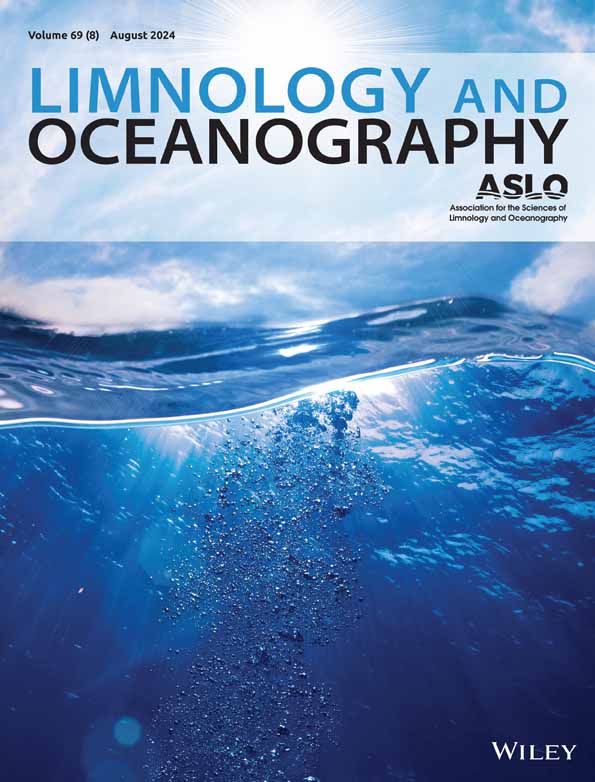A global meta‐analysis of ecological functions and regulating ecosystem services of freshwater bivalves
IF 3.7
1区 地球科学
Q1 LIMNOLOGY
引用次数: 0
Abstract
Freshwater bivalves are globally distributed, diverse, and common in benthic communities. Many taxa, particularly in the most species‐rich order, Unionida, are declining due to anthropogenic stressors, while a small number of non‐native species have become increasingly abundant and widespread, commonly replacing native bivalve assemblages. To understand how these global changes may impact ecosystems and people, we conducted a meta‐analysis of existing literature quantifying the ecological functions (= supporting or intermediate ecosystem services) and regulating ecosystem services of freshwater bivalves (hereafter “ecosystem services”). Random effects meta‐analysis modeling across 447 case studies revealed a positive effect on human health, safety, or comfort of freshwater bivalve ecosystem services overall and specifically, via effects on native macrofauna, microorganisms, wastes, and pollutants, and the physico‐chemical condition or quantity of sediments. Generally, effects of native species and species within the orders Unionida and Venerida were more significant and positive than those of other freshwater bivalves. No significant overall effect was found for ecosystem services related to zooplankton, algae, invasive species, and the physico‐chemical condition of ambient water. Moreover, a significant bias toward publication of positive results existed for studies quantifying ecosystem services related to algae. These findings illustrate the global importance of the ecosystem services of freshwater bivalves and highlight the need for large‐scale conservation and restoration efforts for their species and populations globally, including those of common species. Our findings also question common assumptions of strong and ubiquitous effects of freshwater bivalves on algae and water condition, cautioning against extrapolating observations across systems.淡水双壳类动物生态功能和调节生态系统服务的全球meta分析
淡水双壳类动物分布全球,种类繁多,在底栖动物群落中很常见。许多分类群,特别是在物种最丰富的目中,由于人为压力而减少,而少数非本地物种变得越来越丰富和广泛,通常取代本地双壳类组合。为了了解这些全球变化如何影响生态系统和人类,我们对现有文献进行了荟萃分析,量化了淡水双壳类的生态功能(支持或中间生态系统服务)和调节生态系统服务(以下简称“生态系统服务”)。447个案例研究的随机效应荟萃分析模型揭示了淡水双壳类生态系统服务对人类健康、安全或舒适的积极影响,特别是通过对本地大型动物、微生物、废物和污染物以及沉积物的物理化学条件或数量的影响。一般来说,本地种和银联目、银联目内种的影响比其他淡水双壳类更为显著和积极。与浮游动物、藻类、入侵物种和环境水的物理化学条件相关的生态系统服务没有发现显著的总体影响。此外,对与藻类有关的生态系统服务的量化研究存在明显的发表积极结果的倾向。这些发现说明了淡水双壳类生态系统服务的全球重要性,并强调了对其物种和种群(包括常见物种)进行大规模保护和恢复的必要性。我们的研究结果也质疑了淡水双壳类对藻类和水条件的强烈和普遍影响的普遍假设,警告不要在整个系统中推断观察结果。
本文章由计算机程序翻译,如有差异,请以英文原文为准。
求助全文
约1分钟内获得全文
求助全文
来源期刊

Limnology and Oceanography
地学-海洋学
CiteScore
8.80
自引率
6.70%
发文量
254
审稿时长
3 months
期刊介绍:
Limnology and Oceanography (L&O; print ISSN 0024-3590, online ISSN 1939-5590) publishes original articles, including scholarly reviews, about all aspects of limnology and oceanography. The journal''s unifying theme is the understanding of aquatic systems. Submissions are judged on the originality of their data, interpretations, and ideas, and on the degree to which they can be generalized beyond the particular aquatic system examined. Laboratory and modeling studies must demonstrate relevance to field environments; typically this means that they are bolstered by substantial "real-world" data. Few purely theoretical or purely empirical papers are accepted for review.
 求助内容:
求助内容: 应助结果提醒方式:
应助结果提醒方式:


